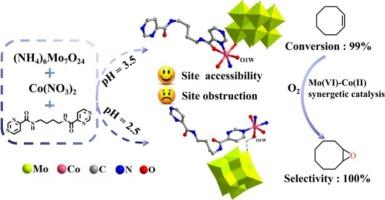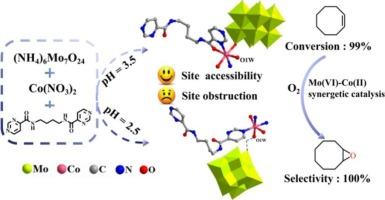ph诱导不同配位金属中心的八胺酸基金属有机配合物催化烯烃环氧化反应
IF 6.5
1区 化学
Q2 CHEMISTRY, PHYSICAL
引用次数: 0
摘要
烯烃的环氧化反应被认为是化学、石油化学和材料科学中必不可少的反应。开发烯烃环氧化反应的高效非均相催化剂具有重要意义。本研究以Co2+为中心金属,在水热条件下与钼酸铵和N,N′-双(4-嘧啶羧基)-1,4-丁烷(bpyb)配体进行组装,通过调节溶液的pH合成了两种新型的多金属氧酸盐(POM)基钴配合物[Co(bpyb)(β-Mo8O26)0.5(H2O)]·H2O (Co (bpyb)(β-Mo8O26)0.5(H2O)]·2H2O (Co- pomoc -2),并用单晶x射线衍射、XPS、PXRD和IR对其进行了表征。两种Co- pomocs表现出不同的Co(II)原子配位模式,这使得它们具有不同的Co(II)位点可及性和不同的催化活性。Co-POMOC-1在烯烃环氧化反应中表现出优异的多相催化活性,在55℃O2气氛下,在22 min内,1,2-环氧环辛烷的收率达到99 %,选择性达到100 %。并合成了一种与Co-POMOC-1同构的新型[Zn(bpyb)(β-Mo8O26)0.5(H2O)]·H2O (Zn- pomoc),通过对比探讨其催化机理。系统研究了Co- pomocs中Co(II)和{β-Mo8}位点对烯烃环氧化反应的协同催化作用及其机理。本文章由计算机程序翻译,如有差异,请以英文原文为准。


pH-induced octamolybdate-based metal–organic complexes with different coordinated metal centers for catalytic epoxidation reaction of alkenes
The epoxidation of olefins is considered an essential reaction in chemistry, petrochemistry, and materials science. Developing highly efficient heterogeneous catalysts for the epoxidation reaction of olefins is of great significance. In this work, Co2+ was selected as the central metal to assemble with ammonium molybdate and a N,N’-bis(4-pyrimidinecarboxaido)-1,4-butane (bpyb) ligand under hydrothermal conditions, and two new polyoxometalate (POM)-based cobalt complexes, [Co(bpyb)(β-Mo8O26)0.5(H2O)]·H2O (Co-POMOC-1) and [Co(bpyb)(β-Mo8O26)0.5(H2O)]·2H2O (Co-POMOC-2) were synthesized by adjusting the pH of the solutions, which were characterized by single crystal X-ray diffraction, XPS, PXRD and IR. Two Co-POMOCs exhibited different coordination modes of Co(II) atoms, endowing them with different accessibilities of Co(II) sites and different catalytic activities. Co-POMOC-1 exhibits excellent heterogenous catalytic activity in the epoxidation reaction of olefins, achieving 99 % yield and 100 % selectivity of 1,2-epoxycyclooctane under O2 atmosphere at 55°C within 22 min. Furthermore, a new [Zn(bpyb)(β-Mo8O26)0.5(H2O)]·H2O (Zn-POMOC), which is isomorphous to Co-POMOC-1, was synthesized to explore the catalytic mechanism by comparison. The synergistic catalysis and catalysis mechanism of Co(II) and {β-Mo8} sites in Co-POMOCs for the olefin epoxidation reaction were investigated systematically.
求助全文
通过发布文献求助,成功后即可免费获取论文全文。
去求助
来源期刊

Journal of Catalysis
工程技术-工程:化工
CiteScore
12.30
自引率
5.50%
发文量
447
审稿时长
31 days
期刊介绍:
The Journal of Catalysis publishes scholarly articles on both heterogeneous and homogeneous catalysis, covering a wide range of chemical transformations. These include various types of catalysis, such as those mediated by photons, plasmons, and electrons. The focus of the studies is to understand the relationship between catalytic function and the underlying chemical properties of surfaces and metal complexes.
The articles in the journal offer innovative concepts and explore the synthesis and kinetics of inorganic solids and homogeneous complexes. Furthermore, they discuss spectroscopic techniques for characterizing catalysts, investigate the interaction of probes and reacting species with catalysts, and employ theoretical methods.
The research presented in the journal should have direct relevance to the field of catalytic processes, addressing either fundamental aspects or applications of catalysis.
 求助内容:
求助内容: 应助结果提醒方式:
应助结果提醒方式:


